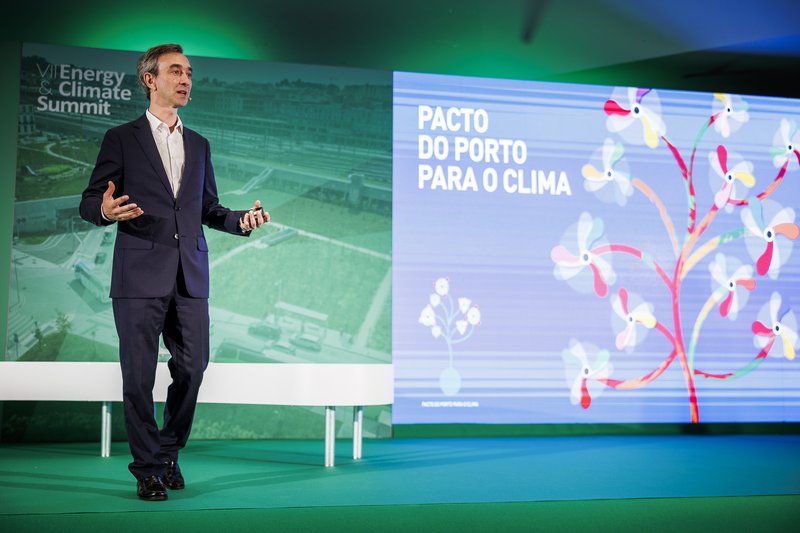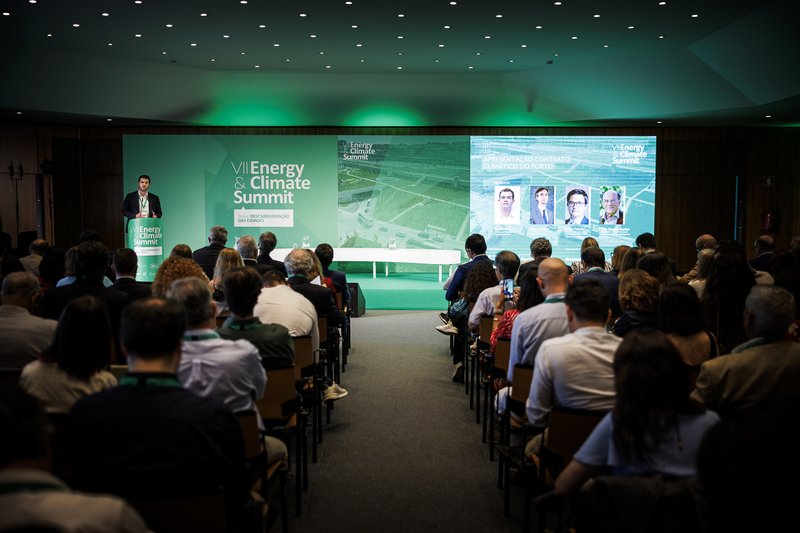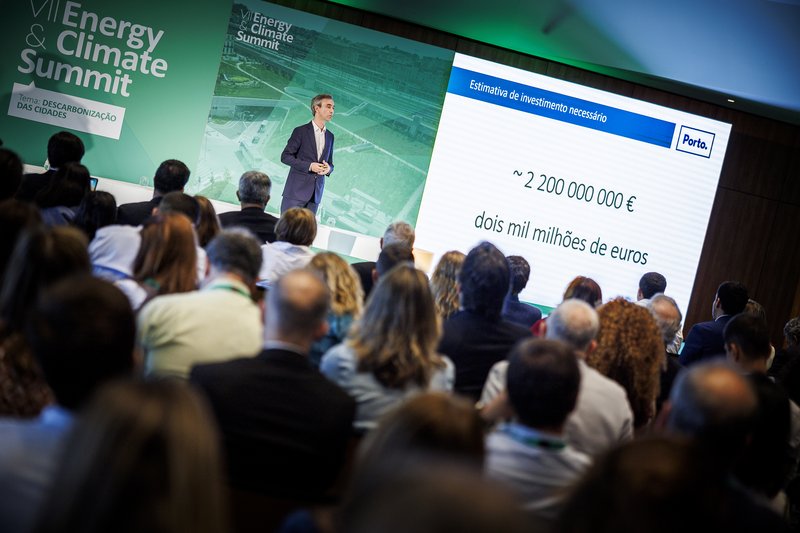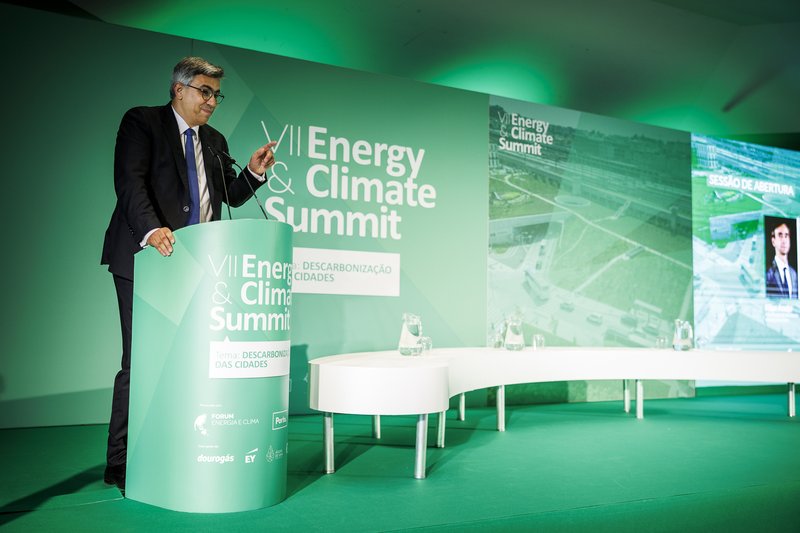Porto Climate Contract foresees EUR 2.2 billion investment in different areas
Article
The Deputy Mayor of Porto, Filipe Araújo, presented the Climate Contract, which aims to achieve carbon neutrality by 2030. Speaking at the VII Energy & Climate Summit, which took place at Alfândega do Porto under the theme 'Decarbonisation of Cities', the mayor revealed the steps taken by the municipality in this direction and the planned investment: EUR 2.2 billion.
'Cities are the main drivers for change. It's often the cities that raise the bar and are then followed by other entities', Filipe Araújo stated at the presentation of the Climate Contract, in which he explained what is being done to bring Porto closer to carbon neutrality by 2030.
The budget, which will exceed two billion euros, will be spread across five major areas of action, supported by public, municipal, private and citizen investment.
It's very difficult to coordinate an energy project without the input of a large structure"
Noting that the Porto Climate Pact, signed in 2022, acted as a kind of trampoline, which led the city to successfully apply to the European Commission's 'Smart Cities with a Climate Neutral Impact' mission, the head of the Environment and Climate Transition department praised the comprehensive work being done on the Climate Contract.
'It's not a project that meets the ambitions of the municipality, the Councillor or the Mayor. It belongs to everyone', Filipe Araújo stressed, noting the importance of municipal companies, partner organisations and the community in implementing measures and meeting objectives.

In front of mayors, researchers, academics, journalists and other participants, the Deputy Mayor clarified that 'it is very difficult to coordinate an energy project without the input of a large structure', emphasising the importance of a good support network in implementing the targets of the Climate Contract, which is based on three fundamental pillars.
The Climate Contract is based on three pillars
The Porto Climate Contract, which has already been signed by 50 organisations, is supported by a Document of Commitments which, in essence, 'underpins this policy', Filipe Araújo explains; by an Action Plan, which 'defines everything that will be done in the coming period', namely the transformative actions that will have to be carried out, he reiterated, and by an Investment Plan.
The third pillar, according to the Deputy Mayor, has yet to be finalised together with the partner organisations, but is estimated to amount to around EUR 2.2 billion. Nonetheless, the Investment Plan, divided into five main areas of action, may be altered according to suggestions made during an analysis every two years.
Major areas of action
With regard to Energy Systems, the Municipality, in collaboration with the Porto Energy Agency, has been studying the best way to create energy communities, taking advantage of its public buildings and setting conditions so that access to renewable energy is simpler and serves the entire population.

The development of the first Renewable Energy Community is currently underway and, if everything goes according to plan, 'will make it possible to lower the energy bill of many families in the municipality'.
With regard to Mobility & Transport, the Deputy Mayor emphasised that the main concern is to 'show people that it's worth taking public transports', justifying the investment that the municipality has been making in this area.
'We can't continue to have 60% of the population travelling around the city by car', Filipe Araújo stressed, pointing out that the City Council wants to offer 22 free trips to two areas of the Andante system, for everyone with a Porto card to enjoy.
Regarding Waste and the Circular Economy, the Mayor emphasised that Porto 'has grown a lot in recycling', adding: 'We want to invest a lot in biowaste'. Waste water treatment, through the Água para Reutilização (ApR - Water for Reuse) project, has also been one of the challenges, making it possible to increase the efficiency of the management system.
Referring to the Built Environment, Filipe Araújo explained that the municipality has endeavoured to renovate already structured buildings, while also investing in the construction of new energy efficient infrastructures.

Regarding the Green Infrastructure & Natural Based Solutions area, the head of the Environment and Climate Transition department drew attention to what was done at the Campanhã Intermodal Terminal. 'If you arrive by bus, you enter and leave a park', referring to the green structure that surrounds the area.
Between 2004 and 2021, the city of Porto has already managed to reduce its greenhouse gas (GHG) emissions by 42%.
'We don't have much time'
The president of the Energy and Climate Forum, Ricardo Campos, who was also present at the event, congratulated the municipality on its journey towards climate action, but left a warning for all those present: 'It's in cities that we have to look for solutions to the challenges.'
'We only have a short time', he said, noting that the best way to try to reverse the damage caused by polluted cities 'is to bring nature back into urban environments'.

Ricardo Campos gave the example of Green Roofs adopted in several city buildings, also emphasising the increased importance of Circular Economy.
The presentation of the Porto Climate Contract was also attended by the member of the European Commission's Mission Council on 'Climate-Neutral and Smart Cities', Paulo Ferrão, and the president of the National Council for the Environment and Sustainable Development, Filipe Duarte Santos.
The content and methodology of the Porto Climate Contract were developed complementarily with the Be.Neutral project, led by CEiiA and funded by the Recovery and Resilience Plan (PRR).